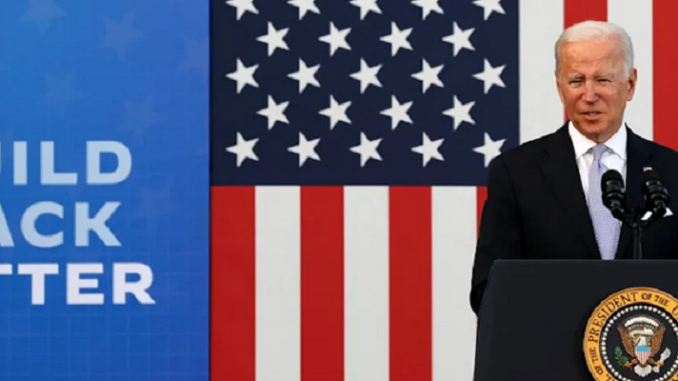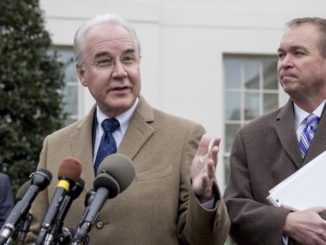
The Build Back Better legislation could affect Texas so powerfully largely because the state’s long-running economic boom, which has produced dynamic job growth, hasn’t erased the persistence of widespread poverty and economic inequality.
by Ronald Brownstein
No state may benefit more than Texas from the social programs included in President Joe Biden’s Build Back Better agenda, an array of recent analyses show — despite the fierce opposition to the bill from the state’s Republican leadership. And over time that dynamic could make the state a crucial proving ground for one of the White House’s core political bets.
Because Texas has so many low-income families and because state policy has done so little to support them, studies show that the state will reap big benefits from the legislation’s key provisions strengthening the social safety net and investing in the education, health care and nutrition of low-income families, though most of them are temporary.
The numbers involved are enormous. One recent Urban Institute study showed that more than 1.5 million uninsured Texans could receive health care coverage under the bill, twice as many as in any other state. Another study, by the anti-poverty nonprofit Center for Law and Social Policy, found that because Texas has so many low-income kids, it would receive more funding than any other state to expand child care programs — more than $11 billion over just the next three years.
Another provision in the bill expanding access to school nutrition programs for lower-income students through the summer could reach more than 3.6 million kids in Texas, nearly as many as California, even though the Golden State has about 20% more children. Still another analysis found that the bill’s changes in the child tax credit could lift a stunning 535,000 Texas children out of poverty, reducing the state’s elevated current rate of childhood poverty by more than 40%.
All these provisions, and others in the current bill, will “provide a system of support for families in Texas that is just unprecedented,” says Cynthia Osborne, director of the Center for Health and Social Policy at the Lyndon B. Johnson School of Public Affairs in the University of Texas at Austin. “It is going to be a game changer in terms of reducing inequality and reducing disparities of opportunity.”
The gusher of federal assistance that the Build Back Better legislation would channel toward Texas — assuming the bill eventually clears the Senate and these provisions survive there — will test a central component of Biden’s political strategy: the belief that delivering material benefits to economically strained families will win back voters drawn to conservative Republican messages on cultural and racial issues.
Although Biden narrowed the GOP’s margin of victory in Texas in 2020 — and showed significant gains in the state’s largest metropolitan areas — he still faced cavernous deficits among working-class White voters across the state and suffered surprising erosion among working-class Hispanics, especially near the southern border, where immigration issues are most salient. The broad array of direct benefits the bill would provide, especially to Hispanic families facing elevated levels of poverty, may represent Democrats’ best chance to reverse those trends — if not in the 2022 elections, which may come too soon for these programs to be fully felt, then at least by 2024.
Republicans in Texas, as elsewhere, are mobilizing to disparage the bill as accelerating inflation, raising taxes, discouraging work and rewarding undocumented immigrants. But, notwithstanding those arguments, if a panoramic array of new government benefits that will directly touch millions of families cannot restore Democrats’ ability to compete electorally in Texas, it’s not clear what would.
“When the Senate passes this and the President signs it we will have delivered real benefits to people in their lives, and not for the wealthiest people in this country but for the people that go to work every day, some of whom struggle every day,” Democratic Rep. Joaquin Castro of Texas told me. “But it’s incumbent on Democrats to go and talk to folks in their communities. People will see the effects over the course of a year or two years and so forth, but you’ve also got to get out there and talk to people about it.”
Bill would strengthen Texas’ social safety net
The Build Back Better legislation could affect Texas so powerfully largely because the state’s long-running economic boom, which has produced dynamic job growth, hasn’t erased the persistence of widespread poverty and economic inequality. In census figures, Texas’ poverty rate (at 14%) was one-third higher than the national average and the poverty rate for children was even higher, at almost 1 in 5. Almost 5 million Texans — about one-fifth of the state’s population below age 65 — lack health insurance, by far the largest number of uninsured in any state. Studies have shown that slightly more than 1 in 5 children in Texas do not regularly get enough to eat, “one of the worst rates of childhood food insecurity in the country,” says Marisa Bono, CEO of Every Texan, a group that advocates for low-income families. Overall, the Annie E. Casey Foundation, in its annual Kids Count ranking, places Texas 46th among the states in overall child welfare.
Across each of these measures, the problems are more acute for African American and Latino families. More than one-quarter of Texas Latinos, for instance, lack health insurance and nearly one-fourth of Latino children (as well as one-fifth of Black children) live in poverty, according to studies by the non-partisan Urban Institute. (Though the large number of undocumented immigrants contributes to these trends, the Urban Institute has found that two-thirds of the state’s uninsured, for instance, are US citizens.)
In many of the preponderantly Latino counties through the Rio Grande Valley, where Trump scored his unexpectedly large gains in 2020 — a list that includes Hidalgo, Starr, Zapata and Cameron — one-third of the population is uninsured and one-fourth to one-third live below the poverty line. In Hidalgo, “we have some that are poor, some that are real poor and some that are real, real, real poor,” says Richard Cortez, the county judge there (the equivalent of a county supervisor). “I’ve seen homes with no electricity or running water. That’s the real, real, real poor.” Even in the booming metropolitan counties centered on Houston and Dallas, one-quarter of non-elderly people are uninsured.
With its low-tax, low-service model for promoting economic growth, Texas’ state policy has largely accepted these disparities. Osborne’s center at the University of Texas has identified five state policies that are most critical in improving outcomes for children and families, including setting a minimum wage higher than the federal floor, creating a state Earned Income Tax Credit for low-income working families and expanding eligibility for Medicaid under the Affordable Care Act; Texas is one of seven states that has adopted none of those policies, she says. The federal legislation “is one of the few chances Texans are going to get to have this sort of system of support, because it’s not likely to come from the state,” Osborne says.
Against that backdrop, the federal legislation could transform the extent of the social safety net in Texas across many fronts. Among them:
Health care — Texas is the largest of the 12 states that have refused to expand eligibility for Medicaid under the ACA; today, eligibility is limited to families earning about one-sixth of the federal poverty rate, which Osborne says is the lowest threshold in the nation. The Democrats’ Build Back Better plan would provide generous ACA health care subsidies for no-cost coverage to those eligible for the Medicaid expansion in the states that refused to participate. That change alone could provide coverage to about 1 million uninsured Texans, according to estimates; additional subsidies in the bill to help somewhat higher-income families buy private coverage on the ACA exchanges would raise the total number of Texans gaining insurance under the legislation to 1.55 million, the Urban Institute has projected. That would be about double the number in the next closest state and would reduce Texas’ uninsured rate by nearly one-third.
Childhood poverty — One of the bill’s most significant changes is to increase the value of the child tax credit — and, as important, make it fully available to families with little, or even no, income. Fully 6.7 million children in Texas, just over half of them Latino, would receive at least some benefit from the expanded credit, the Center on Budget and Policy Priorities has calculated; both the center and the Urban Institute project that the credit would lift about 500,000 kids there above the poverty line.
“It’s hard to overstate the importance of this legislation in reducing child poverty,” says Elaine Maag, a senior research associate at the Urban Institute’s Tax Policy Center. “It’s a very direct benefit, and unlike some of the other policies in the legislation that require the state to act for their population to benefit, this is a federal program, so it doesn’t matter who the governor of your state is, you are going to get the benefit.”
Child care and early childhood education — Because Texas has so many low-income families, the Center for Law and Social Policy recently projected that it will receive even more from the bill’s new child care funding over the next three years than more populous California. With subsidies for child care costs extending well into the middle class, the bill would underwrite care for about 2 million Texas children, Every Texan estimates. The state could be a big winner as well from the bill’s provisions creating universal access to prekindergarten for 3- and 4-year-olds; though the state has made progress on that front, more than two-fifths of eligible children there remain unenrolled, slightly worse than the national average, according to the latest federal figures.
One key to the potential impact: Even if the state refuses to participate in the new universal pre-K program (which most expect), the bill allows cities and counties to join on their own. Democrat Rodney Ellis, a commissioner in Harris County, centered on Houston, says that even if the state rejects the money, the county will likely vote to participate. Amid persistent poverty and inequality, he says, the bill offers “a once-in-a-generation opportunity … to change the trajectory of communities that have disproportionately been left out of significant investments.”
Diabetes — The share of Texans with diabetes has more than doubled since the mid-1990s and now significantly exceeds the national average; the numbers are even higher for Blacks and especially Latinos (about 1 in 7 of whom there suffer from the disease). That will make the state one of the big winners from the bill’s provision placing a $35 monthly limit on out-of-pocket expenses for insulin.
“In my district one of the biggest problems we have is the ability of people to afford their medicines, and insulin in particular,” says Castro. “People are struggling with that every day in San Antonio, so this will be a godsend for them.”
Nutrition — Although it has received very little notice, the bill significantly expands nutritional assistance to low-income children who receive free or reduced-priced meals at schools by extending aid through the summer. Again because of the state’s concentration of low-income families, the expanded summer eligibility in the bill is expected to benefit more than 3.6 million Texas kids.
Other benefits — Although precise figures aren’t available, local experts believe Texas may have a disproportionate number of multigenerational households, particularly in low-income communities, which means the state could benefit disproportionately from the bill’s big increase in funding for home health care and elder care services. At the other end of the generational ladder, nearly half of the state’s low-income women of child-bearing age are uninsured, Osborne says, which has contributed to Texas’ elevated rates of infant and maternal mortality. They will benefit from another bill provision requiring states to provide one year of health insurance for new mothers and children. “This stands to have a huge impact on the well-being of infants and moms,” Osborne says.
This broad array of policies looking to bolster low-income and working-class Texans could have a synergistic effect by channeling substantially more money into depressed communities, says Rep. Veronica Escobar, D-Texas, who represents a district in El Paso where nearly one-quarter lack health insurance and almost one-fifth are poor. “This is going to be transformative not just for families and individuals … but for communities,” she said in an interview. “In a community like El Paso that has been economically disadvantaged, when its families have more money in their pockets at the end of the day … what do they do with it? They buy their kids clothes. They take their family to restaurants or a movie. They are able to get into a home they have been dreaming about. These are the things that fuel economic growth and prosperity not just for families and individuals but for communities.”
One final provision in the legislation could multiply all of these impacts on Texas. The House bill provided a kind of legal status for almost 7 million undocumented immigrants in the US, which would allow them to obtain driver’s licenses and to access many of the benefits listed above, particularly the Medicaid expansion. If that legalization provision survives the Senate — which is highly uncertain — it would create protections for 1.2 million undocumented immigrants in Texas, one recent study concluded.
But can Democrats sell it in the state?
The political question is whether this towering wave of new federal assistance will change the equation in a state Republicans have dominated since George W. Bush’s first election as governor in 1994. The 2020 election presented a mixed picture for Democrats. Even as Biden, powered by gains in the largest cities, reduced the GOP’s margin of victory (to 6 points, from 9 in 2016), Democrats failed to make down-ballot gains in congressional or state legislative races, a bitter disappointment after their advances on both fronts in suburban districts during the 2018 midterm elections.
Since then, Biden’s approval rating in Texas has sagged to just 35% in the latest University of Texas/Texas Tribune survey. That’s partly, polls show, because of a broad sense in the state that he has mismanaged the volatile issue of undocumented immigration at the southern border. Given Biden’s decline, most local analysts consider Republican Gov. Greg Abbott a favorite for reelection next year, though his own approval ratings are weak and he faces a dynamic potential Democratic opponent in former Rep. Beto O’Rourke. Texas Republicans are brimming with confidence: With Biden’s position in Texas so tenuous, “I think the circumstances are presenting themselves for a significant wave election in 2022” for the GOP, says Matt Mackowiak, an Austin-based Republican strategist.
Biden has frustrated some Texas Democrats by failing to develop any sustained strategy for improving his position in the state (though his administration has pursued legal challenges to the state over voting, redistricting and its new restrictions on abortion). But the financial assistance the Build Back Better plan would shower on Texas, while unlikely to transform the state’s politics on its own, could provide Democrats their best chance in years to reset their image in the state.
“If you increase people’s economic security in non-college communities of color, we can increase turnout,” says James Aldrete, a longtime Democratic consultant in the state.
Even assuming Democrats finally steer the bill past the resistance of Joe Manchin, D-West Virginia, in the Senate, the party will face many obstacles transmuting it into political gains in Texas. Under the best scenarios, most of its provisions are unlikely to be felt in time to significantly change the dynamics for 2022, analysts in both parties agree. And as Cortez, the Hidalgo official, notes, spending this much new money effectively and efficiently won’t be easy — a problem, others observe, that will be magnified by likely resistance from the GOP-controlled state government to many of the new programs.
An even greater problem may be whether Texas Democrats have the campaign organization and infrastructure to publicize and claim credit for the new provisions — or to rebut Republican arguments against the new spending.
“Those kind of benefits, they exist objectively as numbers but you have to work to turn them into political capital,” says James Henson, director of the Texas Politics Project at the University of Texas at Austin. “And I’m not sure, either nationally or at the state level, there is any evidence the Democrats are prepared to do that.”
While the bill’s benefits for Latino families could be “extraordinary,” adds Lydia Camarillo, president of the Southwest Voter Registration Education Project, “Democrats can’t assume … it is going to trickle down and turn out voters” without a more effective communications campaign than the party has usually proved capable of in Texas.
Moreover, Henson notes, the GOP’s financial dominance and control of state government provide it with enormous leverage to politically tarnish the new programs or shift the campaign dialogue toward other issues. Sen. John Cornyn, R-Texas, recently offered Democrats a preview of those possibilities when he delivered a lengthy floor speech denouncing the legislation as “a reckless tax and spending spree that will benefit the wealthiest of Americans at the cost of working families,” in part by fueling inflation and threatening domestic energy production. The conservative Texas Public Policy Foundation has likewise charged that the bill would benefit undocumented immigrants, discourage work, kill jobs and raise taxes.
Mackowiak sees similar potential vulnerabilities in the bill and points to the preponderantly Hispanic South Texas counties as a critical proving ground for Biden’s belief that kitchen-table benefits can reverse the movement among working-class voters toward the GOP on other issues, particularly immigration and border security. “That’s a great test,” he says. “Where does Starr County and Cameron County go? If BBB passes and it has those things in the final bill … how does that balance out? I generally think economic issues always win out, but these border issues are public safety, public health. It appears down there that the Biden administration is out of touch or making the problem far, far worse than it need be.”
The legislation Texas Republicans have passed making it tougher to vote and the GOP’s aggressive partisan gerrymanders in the state’s recently approved congressional and state legislative maps only add to the hurdles Democrats face in the state.
Even with these obstacles, if the bill passes, by 2024 millions of Texans will be directly benefiting from its provisions. Many more families will have health insurance, fewer will be poor and more will have access to early childhood education and affordable child care, as well as help caring for elderly parents and other benefits. For years, Texas Democrats have beseeched the party to spend millions of dollars on campaign television ads to make the case for the party’s priorities; the Build Back Better bill would trumpet those priorities with billions of dollars in tangible assistance to families across the state.
“It’s a generational investment and benefit to these communities, and it’s in contrast to what was done with the 2017 tax cuts for the wealthiest Americans and the largest corporations by the Trump administration,” says Castro. “If we can’t go out there and sell this, then we have bigger problems than I thought.”
.
Ronald Brownstein is a CNN senior political analyst, regularly appearing across the network’s programming and special political coverage. Brownstein is Atlantic Media’s Editorial Director for Strategic Partnerships, in charge of long-term editorial strategy.



